March 22, 2019
Air Date: March 22, 2019
FULL SHOW
SEGMENTS
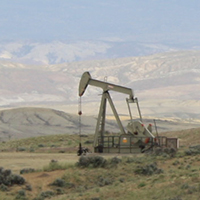
Oil Drilling Blocked for Climate
View the page for this story
A federal judge has found the Bureau of Land Management failed to adequately consider climate impacts when it held lease sales for oil and gas drilling on hundreds of thousands of acres in Wyoming, Colorado and Utah, and has blocked any drilling until the climate risks are reviewed. Vermont Law School Professor Pat Parenteau tells Host Steve Curwood why the judiciary, as “the last line of defense” for environmental law, has increasingly recognized climate change as an issue that must be addressed in proposals for everything from oil and gas leases, to coal leases, to pipelines like Keystone XL. They also discuss the upcoming decision on whether the Juliana, et al v. United States youth climate lawsuit will move forward. (09:50)
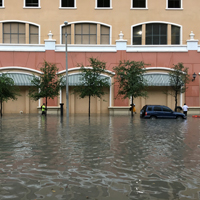
Climate Disasters and Softening Property Values
View the page for this story
Climate change is stoking losses everywhere from the recent floods in Southern Africa to the flooding in the US Midwest. Rising sea levels have also wiped out $16 billion in property values from 2005 to 2017 in the Eastern US, a recent study has found. In the affected coastal communities, homes in danger of high-tide flooding sell for less, compared to homes on higher ground. Nicholas Kusnetz, a reporter for Inside Climate News, joins Host Steve Curwood to discuss how this inevitable economic decline could eat away at local tax bases, devastating coastal communities further. (09:28)
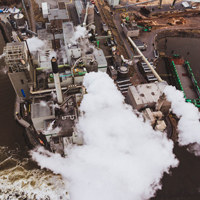
The Racial Gap of Pollution Responsibility
View the page for this story
Fine particle air pollution is especially dangerous for human health, and a well-established body of research has found that minority groups are disproportionately exposed. A new study published in the Proceedings of the National Academies of Sciences documents the racial gap between who’s most responsible for air pollution and who breathes it. Host Steve Curwood sits down with Dr. Christopher Tessum, lead author of the study. (06:11)
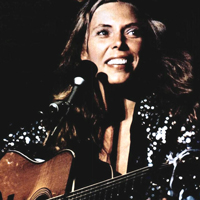
Beyond the Headlines
/ Peter DykstraView the page for this story
In this week's trip beyond the headlines, Peter Dykstra talks with Host Steve Curwood about Donald Trump Jr.'s disbelief at the concept of environmental racism. Then, the two discuss the national security implications of the "bomb genesis storm" that hit the Midwest last week, as well as the recent United Nations Environment Assembly in Nairobi, Kenya. Lastly, they take a listen to an iconic song that helped shape the environmental movement of the 1970s: Joni Mitchell's “Big Yellow Taxi”. (05:06)
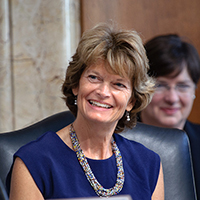
GOP Senator Lisa Murkowski on the 2019 Public Lands Act
View the page for this story
As the Chair of the Energy and Natural Resources Committee, Senator Lisa Murkowski of Alaska has worked for years with Republican and Democratic colleagues to bring together the most sweeping land conservation bill in a decade. The act, signed into law by President Trump on March 12, 2019, designates 1.3 million new acres of wilderness, creates or confirms five new national monuments, protects hundreds of miles of wild and scenic rivers, and also permanently authorizes the Land and Water Conservation Fund. Senator Murkowski joins Host Steve Curwood to discuss the highlights of the Dingell Act and what it brings for Alaska residents, as well as the need to act on climate change. (11:30)

Baboon, “The Observer”
/ Mark Seth LenderView the page for this story
We are closely related to the primates. The great apes look like us; so do the monkeys even though they have tails. Watching an alert olive baboon in the marshes near Kenya’s Mara River, Living on Earth’s Explorer in Residence Mark Seth Lender has come to believe this resemblance has to do with something more than physical appearance alone. (04:14)
Show Credits and Funders
Show Transcript
HOST: Steve Curwood
GUESTS: Pat Parenteau, Nicholas Kusnetz, Christopher Tessum, Lisa Murkowski
REPORTERS: Peter Dykstra, Mark Seth Lender
[THEME]
CURWOOD: From Public Radio International, this is Living on Earth.
[THEME]
CURWOOD: I’m Steve Curwood. Republican Senator Lisa Murkowski of Alaska explains how to pass a huge bipartisan public lands package.
MURKOWSKI: You have the back-and-forth of amendments; you require folks on the ground to really get the buy-in to advance these land and water and conservation provisions. By the time it gets to the floor, you've really built something that truly can be viewed as a consensus package.
CURWOOD: Also, courts are putting the brakes on drilling and pipelines on public lands.
PARENTEAU: I like to say that the courts are now the last line of defense for the environment -- and maybe the Earth, if you want to put it that way. We don't have any leadership in Congress; we obviously have the wrong kind of leadership in the White House; and so it's up to the courts. They are the third branch, and they're holding the line.
CURWOOD: That and more this week on Living on Earth – Stick Around!
[NEWSBREAK MUSIC: Boards Of Canada “Zoetrope” from “In A Beautiful Place Out In The Country” (Warp Records 2000)]
Oil Drilling Blocked for Climate

Oil wells on Bureau of Land Management public lands. The agency leases tens of millions of acres to oil and gas developers every year. (Photo: BLM, Flickr CC BY 2.0)
CURWOOD: From the Jennifer and Ted Stanley Studios at the University of Massachusetts Boston, this is Living on Earth. I’m Steve Curwood.
A federal court has blocked the Trump Administration from drilling for gas and oil on almost a half a million acres of public lands in Wyoming, Utah and Colorado, until it accounts for the climate impact. The Wild Earth Guardians and Physicians for Social Responsibility won the temporary ruling from US District Judge Rudolph Contreras in Washington.
In a few moments we’ll get the perspective of Vermont Law school professor Pat Parenteau on that case. But first we turn to him for an update on the Juliana case in Oregon, which was filed in 2015 by about two dozen young people claiming the federal government is depriving them of their constitutional right to a decent life by failing to address climate change.
So far the government has kept this major case from coming to trial, but lawyers for the young people keep fighting. Welcome back to the show, Pat Parenteau, and where’s the Juliana case now?
PARENTEAU: Nice to be back with you, Steve. So the Ninth Circuit panel, a three judge panel, has scheduled an oral argument for June on whether the case should go to trial, or whether it should be dismissed.
CURWOOD: Wait a second -- haven't we heard that before? I mean...
PARENTEAU: [LAUGHS] We've heard that many times, four times to be exact. But this is I think the final curtain on Juliana, and whether it's going to go to trial or not, I think will be decided in June. But in the meantime, the plaintiffs in Juliana have also requested that the Ninth Circuit issue an injunction against a whole raft of these fossil fuel projects, including coal mines, and oil and gas, and pipelines and export terminals, LNG terminals; it's really a massive amount of fossil fuel infrastructure that the plaintiffs and Juliana rightly, of course, believe that if all of these things go forward, you know, at some point, you do reach the point of no return, of not being able to achieve any of the targets for emissions reduction that the scientists are telling us we need to achieve. Now, I don't think the Ninth Circuit is probably ready to issue such an injunction. But that request from the plaintiffs is pending. So we're waiting to hear what happens with that.
CURWOOD: So how significant is this decision that the Bureau of Land Management failed to adequately consider climate change when it leased land for oil and gas drilling?
PARENTEAU: Well, it's significant in terms of scale, this is 460,000 acres of public lands being devoted to oil and gas production, and the amount of oil and gas that could be produced is also very, very significant. It's also significant in terms of it's the latest in a growing line, really, of cases that are slowing down and delaying a lot of this fossil fuel development -- oil and gas, coal mines, gas pipelines -- and the courts are saying, you know, you can't keep building all of this infrastructure that's going to be in place for decades, pushing us further and further towards the climate cliff, without doing a better job of analyzing what those impacts are, quantifying the amount of emissions that you're authorizing, and thinking harder about whether this makes sense. So it's an important decision on a lot of levels.
CURWOOD: So what does the judge say, in this particular case regarding these leases, that the Bureau of Land Management has to do to satisfy him about this thought process?
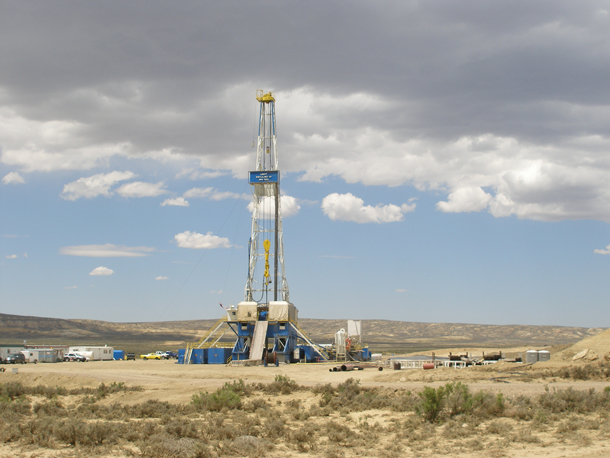
Wyoming’s High Desert District contains some of the leased parcels that a federal judge said BLM has so far failed to adequately assess for the climate impacts that would come of oil and gas drilling. (Photo: BLM Wyoming, Flickr CC BY 2.0)
PARENTEAU: First thing he said is stop making excuses about not being able to quantify the impact of what you're talking about. You've got data, and he pointed to a number of studies that were in the record. He said, You just didn't take the time and effort to actually analyze and compute this data, quantify these emissions. And you also said, Well, we can do it later. And he said, no, that you can't do it later. The leases are the point of no return. Once the federal government has committed to leasing these areas, it's a contract, it's a binding legal contract, the companies bid lots of money to buy these leases. They don't give them away. And so he said, No, this is the time to do this kind of analysis. Yes, it requires some prediction and projection. Yes, there's some uncertainty, you can factor all that in to your analysis. But you can't simply throw up your hands and say, Oh, we just don't know how to do it. That's really not true. He just rejected that out of hand.
CURWOOD: So what does the law tell us, Pat, about the need to put potential greenhouse gas emissions from one particular project into the context of other greenhouse gas emissions?
PARENTEAU: Yeah, that's a key question. So the court also said, you not only have to consider the effects of these immediate leases that you're offering, but you're doing other leases in other parts of the West and other public lands. And you're also doing other kinds of fossil fuel related developments -- coal mining, for example. And he said, you know, you really do have to look at the cumulative effect of the combined efforts of the federal government to produce and sell all of this fossil fuel. And again, he's relating this to the science of climate change, which basically says, the only number that really matters is how much of this carbon is actually getting into the atmosphere. It's the cumulative loading of the atmosphere that's the problem, it's not any one source or another, it's the sum total of all of them. And so the judge is saying you, you have to at least acknowledge that it isn't just these few leases we're talking about. It's a massive energy development push that's underway, and it's pushing us closer and closer to what people call the climate cliff. Now, he's not saying you have to quantify it down to the last digit. But he is saying you've got to bound within some range the amount of leasing and emissions that you're creating, and you've got to link that in some way to what the climate science is telling us is the limit, the carbon budget limit, that we can live with.
CURWOOD: So the judge is not saying, Well, you can't do this, because it's going to release so much greenhouse gas, you're going to destroy livability on the earth. And yet it sounds like with the procedural questions that, he's really throwing a spanner into the works of developing this stuff. I mean, how long would it take for the BLM to comply with what this judge wants to move forward?
PARENTEAU: Yeah, it is going to take them a while because the amount of calculations and projections and margins of error, you know, that's going to require models. They do have some models that they can use, but they've got to input the data, analyze it, and then they've got to justify, if they're not going to hold off on these leases or basically rethink the whole idea of granting these leases. The judge has made it clear, he says, I'm going to want some sufficient explanations from you, once you've done your calculations as to why it makes sense in the public interest to keep moving forward. And on that point, actually, I can't fault the judge here because he did not require what's called a social cost of carbon calculation. He distinguished his decision from some other courts that have required that analysis by saying, well, the Bureau of Land Management isn't claiming large economic benefits as they were in some of these other cases. But we all know that that's the thing that's driving this oil and gas development. So the point here is, in addition to looking at the science of climate and the consequences, there's also an economic cost to developing all this oil and gas and that's not being calculated and included in the decision making process as well.
CURWOOD: So the environmental groups that brought the suit here, to what extent are they hoping that maybe this will stall things enough for the clock to run out and there might be another administration?
PARENTEAU: Yeah, that's really the goal of a lot of these, what we call "whack-a-mole" cases where you're going after individual coal mines, pipelines, oil and gas leases. You're buying time if you're an environmental group, and if you're concerned about climate; you're waiting for 2020, you're hoping to stall the Trump administration's massive push to develop all these resources and allow for the election to replace the leadership in Washington with the hope that there'll be different decisions and different priorities come 2020.
CURWOOD: This approach is happening in a number of cases. I mean, there wasn't any leasing involved in the Keystone XL decision. But kind of the same thing I think I heard from the court, well, you guys haven't worked out the appropriate details vis-a-vis the climate risk here.
PARENTEAU: Yeah, it is. It's very similar, and the same with some of the gas pipeline cases that have been held up by the federal courts. I like to say that the courts are now the last line of defense for the environment, maybe the earth if you want to put it that way. We don't have any leadership in Congress, we obviously have the wrong kind of leadership in the White House. And so it's up to the courts, and they're faced with a difficult decision because they're really not supposed to be making policy decisions. But on the other hand, when they, when they see agencies ramming these kinds of fossil fuel projects through without careful analysis, without what the law calls a hard look, they're stopping them, left and right. I mean, the Trump administration is something like two and 30 in federal court with their roll back initiative. So the courts, they are the third branch and they're holding the line.
CURWOOD: Pat Parenteau is a professor at Vermont Law School and currently a visiting professor at the University of New Mexico Law School in Albuquerque. Pat, thanks so much for taking the time with us today.
PARENTEAU: Thank you, Steve.
Related links:
- The Washington Post | “Federal judge demands Trump administration reveal how its drilling plans will fuel climate change”
- Federal Judge Rudolph Contreras’ written opinion on the case
- Our Children’s Trust is representing the Juliana plaintiffs
- About Professor Pat Parenteau
[MUSIC: Patty Larkin, “Banish Misfortune/Open Hand” on Angels Running, Tradition Irish/arr.Richard Thompson, BMG Records]
CURWOOD: Coming up – floods are increasing, from major disasters to so-called nuisance flooding. That’s just ahead here on Living on Earth, stay tuned.
ANNOUNCER: Support for Living on Earth comes from Sailors for the Sea and Oceana. Helping boaters race clean, sail green and protect the seas they love. More information at sailors for the sea dot org.
[CUTAWAY MUSIC: Patty Larkin, “Banish Misfortune/Open Hand” on Angels Running, Tradition Irish/arr.Richard Thompson, BMG Records]
Climate Disasters and Softening Property Values
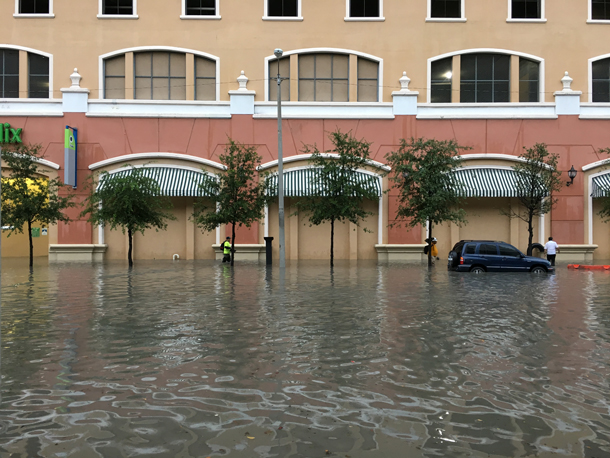
Nuisance flooding is taking a toll on property values in coastal cities such as Miami, Florida. (Photo: Phillip Pessar, Flickr CC BY 2.0)
CURWOOD: It’s Living on Earth, I’m Steve Curwood. Climate change is making weather catastrophes worse, including the killer Cyclone Idai that came ashore March 14 in Beira, Mozambique. Winds of more than 100 miles an hour and a twenty-foot tall storm surge flooded 90 percent of the buildings, decimating this coastal city of about a half million people. The BBC had a reporter on the ground.
REPORTER: We’ve been traveling through areas devastated by the force of this storm. Every single street that you go down, houses that have literally been blasted away by the force of the wind, inundated with water. People coming out to us begging for food, fresh water. There’s no electricity here and a great shortage of any of the basic necessities of human life.
CURWOOD: Beira was the first part of Southern Africa to be hit hard, but as the storm moved west intense rains and high winds ravaged other parts of Mozambique, Malawi and Zimbabwe.
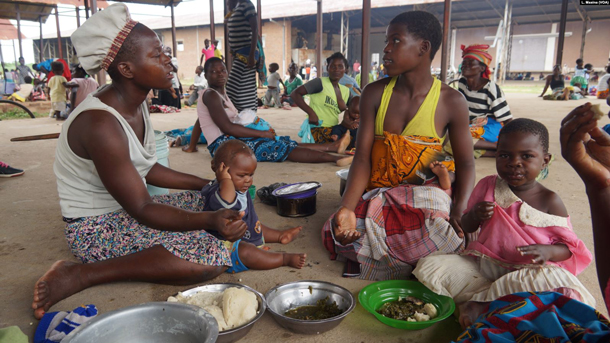
Cyclone Idai and the resulting damage have resulting in a death toll of hundreds of people, and has displaced thousands more, including these people in the Bangula evacuation camp in Nsnje, Malawi (Photo: L. Masina, Voice of America, Wikimedia Commons, Public Domain)
The UN says this is one of the worst weather-related disasters ever to hit the Southern hemisphere. The millions of people in these poor countries are ill-equipped to handle the dire aftermath, and death tolls are unknown but likely to be in the thousands.
And at the same time halfway around the world a so-called “bomb-o-genesis” storm and spring melt unleashed record flooding in the Midwestern US, centered in Nebraska.
REPORTER: This morning from Nebraska to Wisconsin, historic river flooding from rapid snow melt and ice jams, leaving at least 2 dead and 2 missing. In Nebraska the destruction wide-spread, roadways completely crumbled. The force of the water so strong it took out the Spencer Dam, causing an 11-foot wall of water to devastate 3 surrounding counties. And rivers cresting at historic levels. In Waterloo the Elkhorn River breaking its 1962 record, swelling over 17 feet in just 5 days.
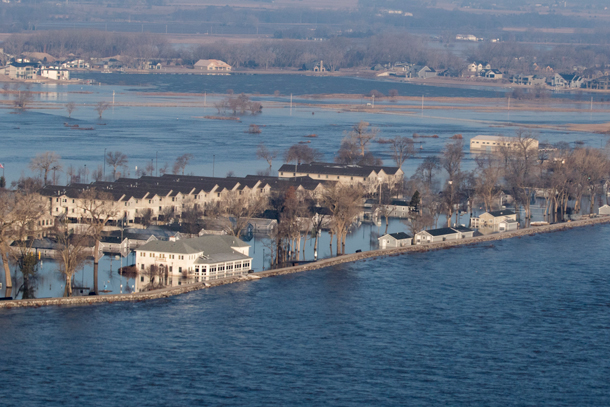
Camp Ashland, Nebraska was one of the Midwestern towns inundated by flooding in the past number of weeks. (Photo: Staff Sgt. Herschel Talley, Nebraska National Guard, CC BY 2.0)
CURWOOD: The flooding could actually be seen from space and prompted a state of emergency declaration in Nebraska, where 74 cities were inundated with flood waters. Countless homes and farms were damaged and livestock were lost. Rising surface temperatures linked to climate disruption make these storms more intense and destructive, leading to billions of dollars in damages. Sea level rise can be less dramatic, but in coastal areas it is also taking a financial toll that concerns property owners.
New research finds the values of coastal homes in flood prone areas in the US are taking a hit, with homeowners getting less for properties in danger of high tide flooding, the First Street Foundation reports. From 2005 to 2017, their study found nearly $16 billion in coastal property value has already been lost from 17 states on the East coast, and the seas keep on rising.
Nicholas Kusnetz is a reporter for Inside Climate News. He joins us now. Nicholas – welcome to Living on Earth!
KUSNETZ: Hi, thanks for having me.
CURWOOD: First, explain, what is nuisance flooding and how does that affect property values?
KUSNETZ: Nuisance flooding is the kind of recurrent flooding that happens along the coast in a lot of tidal areas where high tides will spill over the banks and creep into neighborhoods. And nuisance flooding has been occurring much, much more frequently over the last few decades, as sea levels rise.
CURWOOD: So how does this affect property values?
KUSNETZ: First of all, it's as the name suggests, it's a nuisance. When roads flood, people have trouble getting to work. People have trouble getting around their neighborhoods. But it also causes a lot of damage, it can damage cars, it can creep into homes, and ruin lawns, and basements, and require a lot of work to protect the homes too. In a lot of areas that are more vulnerable people are even raising their houses, elevating them up above the flood zone. So there's a lot of costs that it can impose on people who live in these areas.
CURWOOD: How does that get reflected, then, in the overall price of a home, and also the aggregate price, where a city might be looking at its tax base?
KUSNETZ: An organization called the First Street Foundation has been publishing some analysis on this. They have compared data on sales of property in neighborhoods with flooding to similar homes, neighborhoods that don't have flooding. And what they found is that, on average, the value of homes in flooded neighborhoods is not keeping pace with their drier neighbors. So people are paying less for these homes. And, across the East Coast and down into Alabama and Mississippi, they found that over the past decade or so, in total, that equates to almost $16 billion in losses for homeowners.
CURWOOD: So, what are some of the potential consequences of this in terms of the tax base?
KUSNETZ: Well, for a lot of cities and towns, I think most cities and towns, one of the leading sources of revenue is property taxes. This is a big looming problem for a lot of coastal communities, particularly smaller ones, where the areas that are flooding is a bigger percentage, just of the area of the town. City governments are thinking about this, and they're trying to figure out how do we get out ahead of this? I mean, we need to protect our coastal areas. But we also don't want to send people running, selling their homes and sending property values crashing, because that could then undermine our ability to protect the areas, to come up with the revenue needed to build sea walls and fund adaptation measures.
CURWOOD: You know, many American homeowners are paying mortgages, how does that figure into all of this?
KUSNETZ: Well, Freddie Mac, the federally backed mortgage bank, actually warned about this potential problem a few years ago. Back in the 2008 housing crisis, part of what happened was that property values dropped, and they dropped, for many people, below the amount that they owed the bank. And then people decided I'm not going to continue to pay this mortgage. I mean, it makes no sense for me. So, unlike then, when there was maybe some hope of property values coming back up, if my home value's dropping because of rising seas, there's a pretty safe bet that it's not going to go up. And so that starts to happen in some coastal areas, and people start deciding not to pay their mortgages. It could lead to mortgage crisis, localized, even regional, where basically, mortgages start going under, and it can cause real problems for, not just for homeowners, and the banks, but then for cities as well, with the kind of blights in certain neighborhoods where, you know, you have abandoned homes that we saw in the last crisis.

Ocean City, New Jersey, showed the greatest loss in property value between 2005 and 2017, with the resort town losing about $500 million, according to the analysis from First Street Foundation. (Photo: Flickr CC)
CURWOOD: Where might this potential economic downturn related to coastal housing, where might that rank?
KUSNETZ: Well, this Freddie Mac report from a few years ago, warned that while the losses might not be sudden in the way they were with the Great Recession of a decade ago or so, in aggregate, they could outrank it. So you know, we could be looking at economic losses much greater than we saw with the Great Recession.
CURWOOD: Looking back to Katrina, for a moment, there were folks in the Lower Ninth Ward who'd worked all their lives to pay off their homes. And when they got flooded out, and the homes are pretty useless, they felt like they were holding the bag, those folks whose homes were mortgaged to the hilt just kind of dusted their hands off, and walked away.
KUSNETZ: It's interesting, you brought up New Orleans and Katrina. A lot of people I've talked to point to New Orleans as an example of some of the bigger issues we're talking about where sea level rise can start to undermine a city's tax base and wellbeing. I mean, after Katrina, the population of the city was cut by a dramatic amount. And a lot of people went to Houston, other cities, and didn't come back and the city really struggled to get back on its feet as a result of that. So that's the kind of thing that you could see in a lot of other cities.
CURWOOD: Okay, so what steps can coastal governments take, then, to protect their land and residents? What can they do?
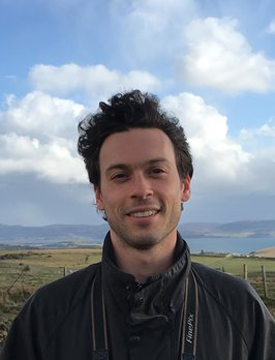
Nicholas Kusnetz is a reporter for Inside Climate News. (Photo: Courtesy of Inside Climate News)
KUSNETZ: Well, there’s a few important things to remember. I mean, first of all, even if we were to stop emitting greenhouse gases today, the seas would continue to rise. So, this problem would continue to get worse. So, there's a certain amount of this baked in because of what we've already admitted. That said, there is a lot that cities and towns can do, from the local all the way the federal level. I mean, one thing, they need to stop building in vulnerable areas. Any new development there is a problem that we're going to have to deal with down the road. But they also need to re-examine, you know, how they finance local governments, I mean, cities that are relying on coastal property values, particularly, beach towns and resorts where this is their main source of revenue, they need to start thinking about, okay, well, how do we replace this, and slowly moving to something so there isn't some kind of shock. There's also programs that can be put in place to provide incentives to homeowners in the short term to protect their homes, and in the longer term, to move out of these areas. There's buyouts, and the federal government does have programs like this, a lot of it is funded through FEMA. And there's the National Flood Insurance Program which is the primary insurer for most people in flood zones. So, that program, as it's structured now, a lot of the time, just provides incentives for people to build back just as they had been after a storm for example. So, Congress could look at that program and start to restructure it so that it encourages people to move away, and when they do build back, to build back higher and stronger, and to provide money to help people move out of these vulnerable areas.
CURWOOD: Nicholas Kusnetz is a reporter for Inside Climate News. Nick, thanks for taking the time with us today.
KUSNETZ: Yeah, it was my pleasure.
Related links:
- Inside Climate News | “Coastal Flooding is Erasing Billions in Property Value as Sea Level Rises. That’s Bad News for Cities.”
- First Street Foundation
- Read the report from the First Street Foundation
[MUSIC: Airto Moreira, “Redland” on Life After That, Narado World]
The Racial Gap of Pollution Responsibility
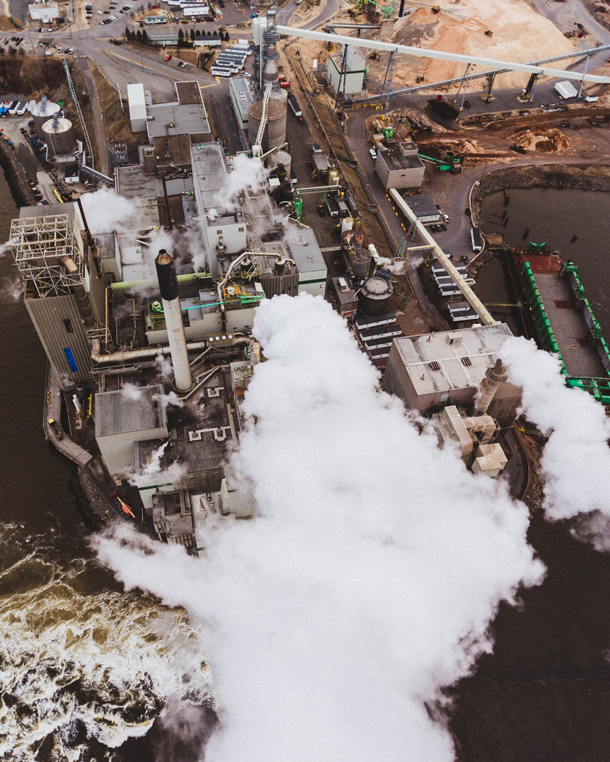
Emissions rising from working factories. (Photo: Unsplash, Desmond Simon)
CURWOOD: Air pollution is common in the US and studies show that African American and Hispanic communities are disproportionately affected. And now a study published in the Proceedings of the National Academies of Science documents the racial gap between who’s responsible for air pollution and who breathes it. Here to tell us more is Christopher Tessum, a research scientist at the University of Washington, and he joins us from Seattle. Welcome to Living on Earth!
TESSUM: Hello. It's great to be here.
CURWOOD: So talk to me, what kind of air pollution are we talking about? And why is it dangerous to public health?
TESSUM: In our study, we looked at fine particulate matter, or PM2.5. These are particles that are basically so small that you can't even see them. When there's a lot of PM2.5 pollution in the air, it will show up as kind of a haze. But otherwise, you can't see it at all. These particles are so small, they go all the way down into your lungs and get stuck in the very bottom. And then they cause inflammation, which can lead to problems with your heart problems, with your lungs, and eventually it can contribute to death.
CURWOOD: How important is the risk of air pollution for environmental health?
TESSUM: Ambient exposure, to PM2.5, just fine particulate matter is the largest environmental cause of pollution. Ambient air pollution causes about 4% of total deaths United States, which is more than three times the number caused by motor vehicle crashes.
CURWOOD: Your research added some statistical certainty that racial and ethnic minorities are acutely vulnerable to air pollution because of where they live. There's also an interesting element that you put in here, which is to look at who's responsible for those pollutants that are inhaled disproportionately by blacks and Hispanics, what made you consider the exposure here for this, and the responsibility by blacks and Hispanics, and what was your measurement for that responsibility?
TESSUM: One way of thinking about it is that there's these two kind of problems or issues in society that, you know, people spend a lot of time thinking about, talking about. One is inequity in income. And then there's kind of inequity, racial ethnic inequity and exposure to environmental burdens. So what we're trying to do is trying to look for a way to look at these two problems together, because they're really related. When you have somebody operating an electricity generator, they're not just operating it for fun, you know, and they're not just sending the pollution out of it for fun, they're doing that to meet an economic demand for electricity. We try to connect, you know, who's demanding products and services with who’s emitting the pollution and who's exposed to that pollution. And so in order to do that, we came up with a metric called pollution inequity, which basically is kind of the percent difference in between the amount of pollution and the amount of exposure to pollution that people are causing, through their activities, their daily activities, their consumption of goods and services, as we call it. So the percent difference in between that, and the amount of pollution that those people are being exposed to.
CURWOOD: So what exactly were your results; give me some numbers here, compare the responsibility versus the burden for pollution among blacks, Hispanics, and then whites.
TESSUM: So we find that blacks and Hispanics are bearing kind of on average, we call a pollution burden, which is that they're exposed to more pollution than they're causing. So we find that black people are exposed to about 56% more pollution than they cause. And Hispanic people are exposed to about 63% more pollution than they cause. Conversely, we find that white people and other races on average are exposed to about 70% less pollution than they cause.
CURWOOD: So 17% less pollution than generated by their own consumption, you're saying?
TESSUM: Yeah.
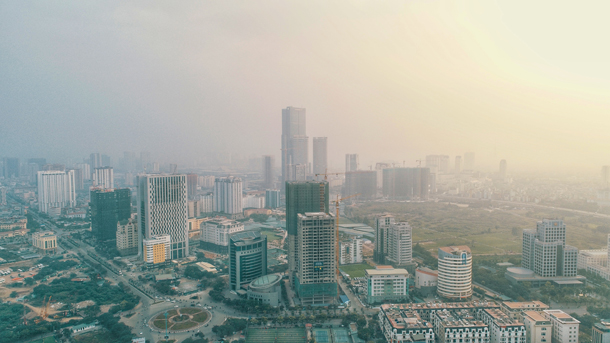
The “haze” that Dr. Tessum was referring to. (Photo: Unsplash, Anz Designs)
CURWOOD: Now, from your findings, what are the overall driving factors for the air pollution problems that create these particles? And how did you measure the pollution for the folks who are in your study?
TESSUM: One of the kind of tricky parts of all this is that there's not any kind of one or a couple of different things that are causing all this air pollution, it's really a lot of different things. So historically, things like coal power plants, and heavy duty trucks and light duty cars were kind of the, maybe the three dominating factors. But over time, there's been a lot of regulation in those sectors for the power plants and the cars and the trucks, so that now, you know, the pollution is less from those; hasn't necessarily been decreasing as much for some other sectors -- in agriculture, is a more important one over time; industrial sources, things like that.
CURWOOD: So many sources of air pollution have been decreasing along the years thanks to regulation, but the inequity of exposure seems to have remained the same. So why are blacks and Hispanics contributing less to pollution but still being affected more do you think?
TESSUM: What we saw in the study was that the amount of pollution per dollar spent was getting less over time. But the thing is that black and Hispanic people are still living in places that had higher pollution levels, and white people and other races are still spending more money on average. So the underlying factors that were contributing to the inequity are staying the same, it's just that kind of pollution intensity of the economic activity has decreased over time.
CURWOOD: So when you look at an urban area, what do you see in terms of this racial disparity in terms of exposure to pollution?
TESSUM: There's kind of this long history of why people live in certain neighborhoods in the US, you know, and why certain racial ethnic groups tend to live in certain neighborhoods that may be nearer to highways, things like that, within a certain city. And different racial ethnic groups tend to live in different neighborhoods. It turns out that the neighborhoods that black and Hispanic people live in tend to have higher concentrations of PM2.5.
CURWOOD: So what's next for you for research?
TESSUM: Yeah, so there are a couple of things that we kind of ran into while we were doing this study that we would be interested in exploring a little bit more. One is looking at how this type of story plays out on a global scale, kind of looking at how maybe pollution in one country is induced by consumption in another country. And another thing that we're interested in is that this kind of pollution inequity metric that we've introduced here could really be used to study all kinds of different things, you know, things like inequities in water pollution, climate change, things like that.
CURWOOD: Christopher Tessum is a research scientist at the University of Washington and lead author of the study we've been discussing. Christopher, thanks so much for taking the time with us today.
TESSUM: Thank you. It was great to be here.
Related links:
- NPR | "Study Find Racial Gap Between Who Causes Air Pollution and Who Breathes It"
- The study in PNAS | “Inequity in Consumption of Goods and Services Adds to Racial-Ethnic Disparities in Air Pollution Exposure”
- CNN | "Hispanic and Blacks Create Less Air Pollution Than Whites, but Breathe More of It, Study Finds"
[MUSIC: Kim and Reggie Harris, “Freedom Is a Constant Struggle” on Get On Board, by Roberta Slavitt, Appleseed Recordings]
Beyond the Headlines
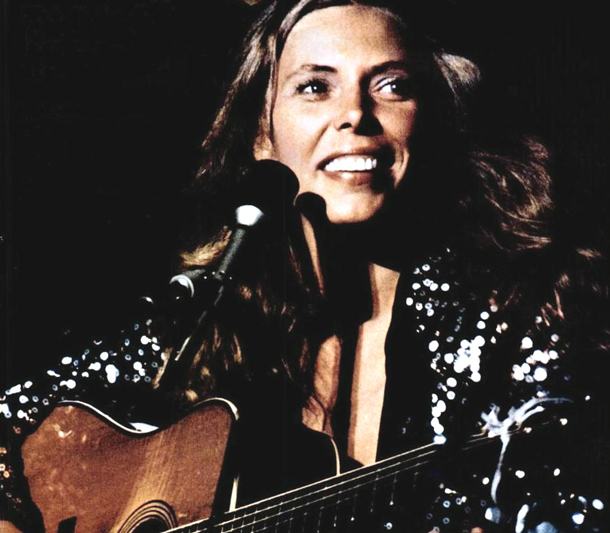
Joni Mitchell’s “Big Yellow Taxi” is renowned for its environmental themes, including references to DDT, which was banned in the United States two years after the song’s release. (Photo: Asylum Records, Billboard, Wikimedia Commons, Public Domain)
CURWOOD: Well, let's take a look beyond the headlines now with Peter Dykstra. Peter's an editor at Environmental Health News, that's EHN.org and DailyClimate.org. He's on the line now from Atlanta. Hey there, Peter, what's going on?
DYKSTRA: Hi, Steve. Once again, the outrageous tweet of the week goes to Donald Trump, except in this case, it's Donald Trump Jr. He said, and I quote, "Just when you thought you've seen it all, now we have RACIST AIR" - racist air in caps, of course - "this insanity has to stop." So what that tweet is about is referring to the story you just had on environmental racism. The Donald Jr. doesn't really want to acknowledge the widely accepted fact that poor and minority communities get stuck with more air pollution, water pollution, land pollution, than they have responsibility for producing. Environmental racism is a real thing everywhere except apparently in Trump world.

Donald Trump Jr. tweeted out a statement in which he claimed the concept that air pollution could disproportionately affect minority groups was “insanity”. (Photo: Gage Skidmore, Flickr, CC BY-SA 2.0)
CURWOOD: Well, then maybe that's where the insanity needs to stop. What else do you have for us?
DYKSTRA: A little bit on the national security implications of climate change. The so-called bomb tornado that hit the Midwest last week -- we've already talked about it on the show -- partially disabled Offutt Air Force Base near Omaha. That's the base that's the headquarters of the Strategic Command, the part of the military that takes the lead, the tip of the sword, as it were, in any nuclear conflict, either preventing or maybe starting a nuclear war.
CURWOOD: We talked about the flooding earlier in the program, but what happened at the Air Force Base in terms of damage?
DYKSTRA: At one point the flooding covered a full one-third of Offutt Air Force Base. It crippled its main runway and submerged many of the key buildings there.
CURWOOD: And how much is all this going to cost?
DYKSTRA: We don't have a price tag in on it yet. But we do know of a similar climate-linked problem at a military base, again pointing out global security concerns about climate change. There's another facility in Florida called Tyndall Air Force Base in the Florida panhandle. Tyndall was almost completely destroyed by Hurricane Michael. An estimated $5 to $6 billion in destroyed aircraft and destroyed buildings.
CURWOOD: What else do you have for us?
DYKSTRA: The nations of the world met last week in Nairobi, but they met in the wake of a tragedy. About 20 of the people on that Ethiopia Air flight were flying to Nairobi to participate in a UN conference on the environment, on plastics pollution. There were ambitious plans to increase the global effort on plastics. Those plans were derailed by the United States.
CURWOOD: And what did the US say?
DYKSTRA: The US made sure that any reductions in plastics were voluntary rather than mandatory and they just threw obstacle after obstacle in front of the passage of this global measure that would have, at its absolute minimum, acknowledged that we have a global problem with plastics in the ocean.
CURWOOD: Well, we have a tremendous amount of natural gas here in the United States, which of course is used to make plastic. So let's look back to the history vault, and what do you see inside today?
DYKSTRA: March 31st, 1970, a song was released that had one of the most iconic lines about the environment ever. It read, or sang, "Don't it always seem to go that you don't know what you've got 'til it's gone. They paved paradise and put up a parking lot." That, of course, is from Joni Mitchell's 'Big Yellow Taxi.'
CURWOOD: So that was a classic environmental song, 1970, you get Earth Day, you get, what, the Clean Air Act, the Clean Water Act.
DYKSTRA: Right, it was in the middle of an environmental political renaissance, when those laws were passed, the EPA was founded and many environmental groups either started or greatly increased their membership and their influence.
CURWOOD: Thank you, Peter. Peter's an editor with Environmental Health News, that's EHN.org and DailyClimate.org. We'll talk to you again real soon.
DYKSTRA: Thanks a lot, Steve, talk to you soon.
CURWOOD: There's more on these stories at our website, LOE.org. And for your listening pleasure, here's a little Joni.
Related links:
- Huffington Post | “Donald Trump Jr. Gets Roasted Over Ridiculous Hot Take on ‘Racist Air’”
- Omaha World-Herald | “One-Third of Offutt Underwater; at Least 30 Buildings Damaged in Flood”
- The Guardian | “US Accused of Blocking Ambitious Global Action Against Plastic Pollution”
- Joni Mitchell’s “Big Yellow Taxi”
[MUSIC: Joni Mitchell, “Big Yellow Taxi”, Ladies of the Canyon (Reprise 1970)]
CURWOOD: Coming up – bipartisan cooperation yields a huge public lands law for the United States. That’s just ahead here on Living on Earth. Don’t go away!
ANNOUNCER: Funding for Living on Earth comes from you, our listeners, and United Technologies, combining passion for science with engineering to create solutions designed for sustainability in aerospace, building industries, and food refrigeration. UTC companies such as Otis, Carrier, Pratt and Whitney, and UTC Aerospace systems are helping to move the world forward. You can learn more about United Technologies by tuning into the Race to Nine Billion podcast; listen at racetoninebillion.com. This is PRI, Public Radio International.
[CUTAWAY MUSIC: John Coltrane Quartet, “Say It Over and Over Again” on Ballads, by Frank Loesser/Jimmy McHugh, Impulse Records]
GOP Senator Lisa Murkowski on the 2019 Public Lands Act
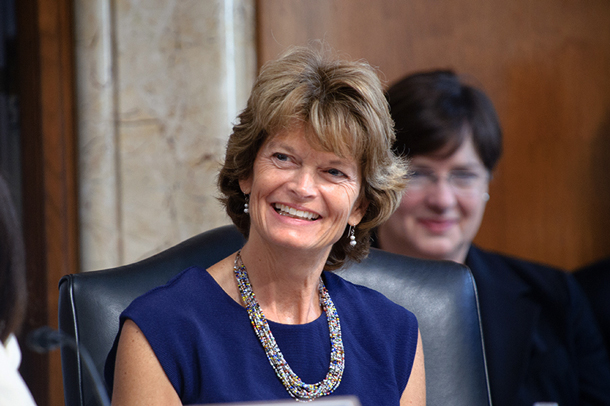
Senator Lisa Murkowski (R-AK) chairs the Committee on Energy and Natural Resources (Photo: Committee on Energy and Natural Resources)
CURWOOD: It’s Living on Earth. I’m Steve Curwood. There is good news for lovers of wild and open spaces. A sweeping public lands conservation bill is now the law of the land.
The John Dingell, Jr. Conservation, Management, and Recreation Act creates or affirms five new national monuments, 1.3 million acres of new wilderness areas, and hundreds of miles of wild and scenic rivers.
The Dingell Act also permanently authorizes the Land and Water Conservation Fund, a lifeblood for conservation efforts. Approved by a 92-8 margin in the Senate and untouched by the House in conference, passage of the measure marks a rare bipartisan moment in Washington. The Republican Senate sponsor, Lisa Murkowski of Alaska, joins me now. Senator, welcome to Living on Earth!
MURKOWSKI: Thank you. Good to be with you.
CURWOOD: So I know that this 700 page public lands package is the result of a lot of hard work. How long did it take, and when did you know this would work?
MURKOWSKI: Well, you summed it up. It is a lot of hard work. It's a lot of good process. It is something that we've been working on for about five years, I would say, there are some parts of the bill that have been around for probably a decade. So there's been a considerable amount of work that has gone into it. But when you ask the question, how did I know that we were going to be successful with this, I'm a strong believer in good process. And if you have an open process where you have bills that go through the committee process on both the House side and the Senate side, you have the back and forth of amendments, you require folks on the ground to really get the buy-in to advance these land and water and conservation provisions. By the time it gets to the floor, you've built something that truly can be viewed as a consensus package. And that's what we tried to do, working with Senator Cantwell as my ranking member for the past several years. We just took the approach that, look, we're going to have to have some give and some take here. But it's got to be bipartisan, and if we're going to be successful, it has to be bicameral.
CURWOOD: Now, it's hard to pick which child -- but in your view, what are the most notable accomplishments of this bill?
MURKOWSKI: Well, I think there's several things; you certainly have a significant conservation focus with this measure. It is notable that we have permanently authorized the Land and Water Conservation Fund. This is that fund that helps to facilitate not only federal lands, acquisition of federal lands, but we also include some reforms within the LWCF account, that ensure that to the state side programs, whether for state parks or ballparks, that they see additional funding, so the conservation piece with LWCF was significant. I think there are so many measures that help to preserve our historic treasures, whether it's battlegrounds or certain historic trails or parks. From the water side we have water management provisions that, for those in the West are very very significant. I have worked across, four different Congresses now in trying to advance a sportsman's package that allows more hunting and fishing and recreation opportunities for sportsmen on our public lands. And then those provisions that really allow for economic opportunities within a region, whether it's something as simple as being able to access gravel in Alaska's North Slope or the expansion of a small airport in South Dakota, these you might not think, are something that would rise to a level of act of Congress. But when it comes to lands and land conveyances, it comes through our committee and we were able to incorporate some 124 different provisions into one significant package. So as you say, you don't want to pick the favorite children, there's just -- there is a lot of good stuff, a lot of substantive matters, and matters that might not make the front page of the New York Times but for that local newspaper, and for that small little economy, bringing in additional tourists bringing in additional economic opportunity, bringing in additional access -- this is big news.
CURWOOD: Indeed. You know, this omnibus package has provisions, I believe, for just about every state. What about your home state of Alaska, what does this include?
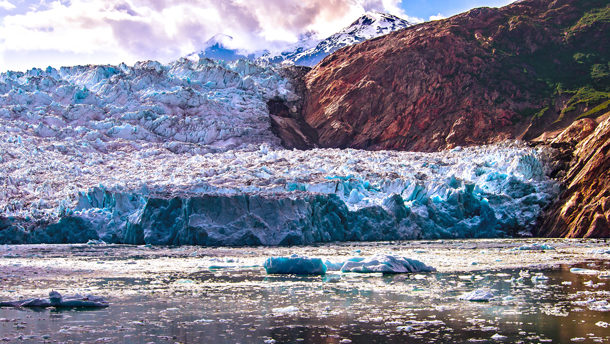
Glaciers like Sawyer Glacier in Alaska’s Tracy Arm fjord are rapidly shrinking because of climate change (Photo: Ian D. Keating, Flickr CC BY 2.0)
MURKOWSKI: One matter that I'm particularly proud of, is what we were able to do to bring about a level of equity for Alaska Native veterans who were serving during the Vietnam War. And while they were over in Vietnam, they were not back home in Alaska during that time period, when, as Alaska Natives, they were allowed to select their native allotments under the Alaska Native Land Claims Settlement Act. And so they missed out on that. So for decades now, they have been trying to address that through an act of Congress. And so finally, after all these years, we have ensured that those veterans who were serving us in Vietnam are able to receive their native allotment that they were promised so many decades ago. We also have a small provision that would provide routing flexibility for an Alaska gas line project, it's effectively a right of way that will allow for greater efficiencies, lower the cost for that time that we're able to get a gas line from the North Slope down to Tidewater, but making sure that you've got your land conveyance issues resolved is an important part of that. More broadly to that, things like a volcano early warning and monitoring act, geologic mapping, making sure that we're understanding our public lands because we have current and up to date maps. So, a whole smorgasbord of different things. But again, initiatives that most would say, well, that's pretty small, but it means a great deal to those local people.
CURWOOD: And by the way, in terms of the Native Claims Settlement Act, where would that land come from?

Climate change has forced recent Iditarod races to change course in order to avoid thinning ice. (Photo: Dana Orlosky, Flickr CC BY-NC 2.0)
MURKOWSKI: Well, much of the federal lands would actually be off limits to the Alaska Native veterans, they would not be able to select in the Tongass National Forest, they would not be able to select in wilderness areas, they would not be able to select up in the 1002 area in Alaska's North Slope, and refuges are also an excepted status. So I can be certain that I will hear from many Alaska Natives who will say, Well, I'm not able to select in my traditional hunting areas, because by federal designation, wilderness has been imposed or it's in the National Forest. But in an effort to make sure that there are no more years that will pass before these veterans are able to receive their allotment, we decided we would work back and forth, we would agree that certain areas would be off limits, but it will be greatly limited in terms of the areas of federal public land that Alaska Natives will be able to select.
CURWOOD: Before you go, Senator, I want to ask you about a big picture item. And that, is where you are on confronting climate change, you know, given that Alaska earns what, 80, 90% of its revenue from oil and gas taxes on the one hand, and then on the other hand, you see Alaska is warming three times faster than the rest of the planet. Also notice that you wrote an op ed recently with Joe Manchin, the democrat from West Virginia about addressing climate change. From your perspective, what could, what should, the United States do now to confront climate change to protect the people of Alaska and the nation -- and for that matter the world?
MURKOWSKI: Well, it is something that we must address. I have long said that climate change is real, it is happening. And if you don't believe that, then I would welcome you to come to Alaska, where you can see the effects of melting permafrost, where you can see how the ice that is typically fast to the shore at this time of year, is simply not there. We just finished up the 1100 mile Iditarod race and part of that race, that dog sled race traditionally goes across a small portion of Norton Sound, but right now, the ice is not stable enough. We've got open areas of water that we have just never seen this time of year before. So it is absolutely there. You mentioned the article that Senator Manchin and I co-authored, the opinion piece. Both of us come from states that are producing states. In Alaska, it's oil; in West Virginia, it's coal. We recognize that we have resources that can benefit Alaskans, West Virginians and Americans. But we also recognize that we have a responsibility, an environmental responsibility, to make sure that as we access our resources, we do it in a way that will limit the environmental impact, that we work daily to reduce emissions. And well, there's a lot of discussion about green new plans, and you know, a decade ago it was all about the Waxman and Markey proposal. What we're trying to shine a light on is what we have been doing as a country to reduce our emissions, and then how are we honestly, realistically and pragmatically going to push that forward and push it forward in a more aggressive manner? And some will say, well, technology is such an easy answer, you need to have a plan. Well, I'll stand before you and tell you that any plan that is going to be successful is going to involve the technologies that allow us to reduce our emissions. Because if you're going to say, well, you just have to stop all production of oil, and that means no more airplanes, no more cars, no more petroleum products; if you're not going to use them, you're going to have to utilize some technologies that will be the alternative to that. So let's talk about what our technologies are, that will help us. So this is something where it's investment in R&D, it is making sure that things like ARPA-E, the "energy think tank," if you will, at DOE is moving forward with appropriate funding, that we're supporting our national labs, that we're working with a private sector in a very collaborative way. There are a host of different ways that we prioritize; it's through legislation, it's through resourcing, and it's through our own personal commitment.
CURWOOD: Lisa Murkowski is Alaska's senior Senator and Chair of the Senate Energy and Natural Resources Committee. Senator, thanks so much for taking the time with us today.
MURKOWSKI: It was great to be with you. Thank you.
Related links:
- Listen to our interview with public lands bill cosponsor Sen. Maria Cantwell (D-WA)
- The Washington Post | “The Senate just passed the decade’s biggest public lands package. Here’s what’s in it.”
- Read the full Senate Bill, the “John D. Dingell, Jr. Conservation, Management, and Recreation Act”
- The Washington Post | “Lisa Murkowski and Joe Manchin: It’s time to act on climate change – responsibly”
- NYTimes | “The Mush in the Iditarod May Soon Be Melted Snow”
[MUSIC: Buddy Rich With the Killer Force Band, “Tales of Rhoda Rat” on No Funny Hats, by Bob Mintzer, Lightyear/Lobitos Creek Ranch Records]
Baboon, “The Observer”
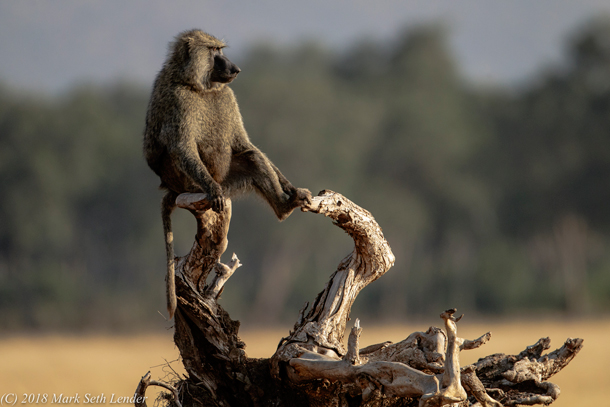
The Olive Baboon lounging on his favorite chair. (Photo: Courtesy of Mark Seth Lender)
[BABOON SOUNDS]
CURWOOD: We are closely related to the primates. The great apes look like us, so do the monkeys even though they have tails. Watching an alert olive baboon in the marshes near Kenya’s Mara River, Living on Earth’s Explorer in Residence Mark Seth Lender has come to believe this resemblance has to do with something more than physical appearance alone.
LENDER: The river bends back and back and back upon itself. A ribbon, tangled in the narrow fabric machinery. And then there are the woods. And then the dried-out grasses, cropped low. And the dead trees. And the marshes, spread like spores, lying dark and wet and tangled with reeds.
On one of the dead trees toppled long ago by elephants, there sits a baboon.
The roots of the tree like an overlarge Victorian chair, suit him. He is comfortable there. As if it was made for him. His back is upright. His aspect… thoughtful. An arm drapes past his knee. One hand holds to the smoothed knob of wood that forms the seat. One foot is placed conveniently on the footrest below him. With the benefit of an unobstructed view his bright eyes, unblinking, look wide and far. He turns his head, all the way left, he turns his head, all the way right. Then straight, towards the marshes. Then leans, cocking head, neck, torso to the side as if trying to see past some obstruction. And to the right again.
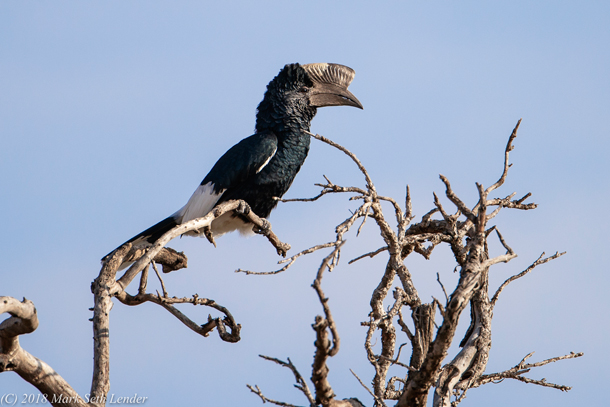
The Black and White Hornbill perches in a dead tree, on the lookout for danger. (Photo: Courtesy of Mark Seth Lender)
The woods behind him he all but ignores (they only merit a glance), this even though there are leopards there, to a certainty. Even though leopards are his lethal enemy. Mostly they hunt at night; he is depending on that.
But there are also lions. Many lions. And they have no use for quotidian conventions. Ensconced amid the constant certainty of lions and the hidden certainty of leopards, the baboon also relies on the open space between him, and them, and in particular that his eyes are not the only ones watching...
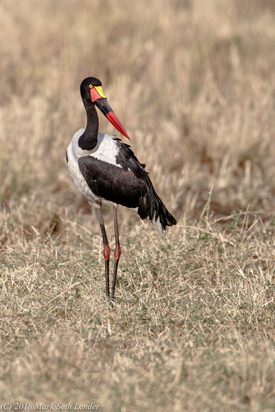
The Saddle-Billed Stork stands alert. (Photo: Courtesy of Mark Seth Lender)
At a distance from the baboon a black and white hornbill sits among the gnarled limbs of a leafless tree, and preens himself. His bill is half the length of him, curved like the sheath of some exotic sword. It tucks and strops the feathers of his wings, the bill folded flat along his back. But one black eye stays open. And keeps watch. Not just up, towards where the great danger might be, some unseen bird of prey that comes soundlessly from the blind direction of the sun. But also, he looks out.
A saddle-billed stork, his black and red and yellow beak like a soldier signaling in semaphore, stands to, ready and alert.
Likewise the black-headed heron high in the uppermost branches where he roosts, and waits, until some signaling device of his own tells him: “Spread your blue wings: Now leap!”
For the birds as for the baboon it is about more than what is there. It is making sure about what is not there. Whether they intend it or they don’t they watch for themselves and also for each other.
The baboon is the last to leave. He climbs down from his chair, grasping with hands and feet. And on all fours walks away. What seemed familiar about him now dissipates; but not very much.
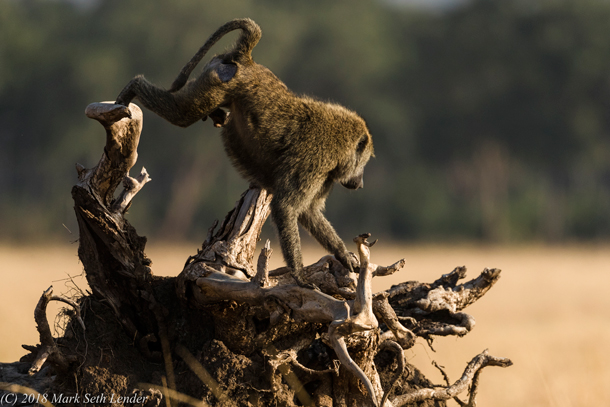
The Olive Baboon disembarks from his post once he is ensured that there is no danger afoot. (Photo: Courtesy of Mark Seth Lender)
CURWOOD: Mark Seth Lender is Living on Earth’s Explorer in Residence.
Related links:
- More about the Olive Baboon
- Information on the Black and White Hornbill
- Find out more about the Saddle-Billed Stork
- More on the Black-Headed Heron
- Mark’s fieldwork was sponsored by Donald Young Safaris
[MUSIC: Soweto String Quartet, “Writing On the Wall” on Renaissance, by Geissman/Coll, RCA Victor]
CURWOOD: Next time on Living on Earth, a visit to one of America’s great national parks, the Everglades.
MAN: Okay, so here's our first alligator...
[SPLASH]
MAN: … and, woah! Active! This is kinda one of the beautiful, unique experiences you get when you're out in the Everglades.
CURWOOD: The beauty and potential perils for the river of grass. That’s next time on Living on Earth.
CURWOOD: Living on Earth is produced by the World Media Foundation. Our crew includes Naomi Arenberg, Bobby Bascomb, Delilah Bethel, Thurston Briscoe, Jenni Doering, Don Lyman, Lizz Malloy, Aynsley O’Neill, Jake Rego, Adelaide Chen, and Jolanda Omari.
Tom Tiger engineered our show. Alison Lirish Dean composed our themes. You can hear us anytime at L-O-E dot org, iTunes and Google play- and like us, please, on our Facebook page - PRI’s Living on Earth. Also, we tweet from @livingonearth. And you can find us on Instagram at livingonearthradio. I’m Steve Curwood. Thanks for listening!
ANNOUNCER: Funding for Living on Earth comes from you, our listeners, and from the University of Massachusetts, Boston, in association with its School for the Environment, developing the next generation of environmental leaders. And from the Grantham Foundation for the protection of the environment, supporting strategic communications and collaboration in solving the world’s most pressing environmental problems. Support also comes from the Energy Foundation, serving the public interest by helping to build a strong, clean, energy economy.
ANNOUNCER 2: PRI, Public Radio International.
Living on Earth wants to hear from you!
Living on Earth
62 Calef Highway, Suite 212
Lee, NH 03861
Telephone: 617-287-4121
E-mail: comments@loe.org
Newsletter [Click here]
Donate to Living on Earth!
Living on Earth is an independent media program and relies entirely on contributions from listeners and institutions supporting public service. Please donate now to preserve an independent environmental voice.
NewsletterLiving on Earth offers a weekly delivery of the show's rundown to your mailbox. Sign up for our newsletter today!
 Sailors For The Sea: Be the change you want to sea.
Sailors For The Sea: Be the change you want to sea.
 The Grantham Foundation for the Protection of the Environment: Committed to protecting and improving the health of the global environment.
The Grantham Foundation for the Protection of the Environment: Committed to protecting and improving the health of the global environment.
 Contribute to Living on Earth and receive, as our gift to you, an archival print of one of Mark Seth Lender's extraordinary wildlife photographs. Follow the link to see Mark's current collection of photographs.
Contribute to Living on Earth and receive, as our gift to you, an archival print of one of Mark Seth Lender's extraordinary wildlife photographs. Follow the link to see Mark's current collection of photographs.
 Buy a signed copy of Mark Seth Lender's book Smeagull the Seagull & support Living on Earth
Buy a signed copy of Mark Seth Lender's book Smeagull the Seagull & support Living on Earth

